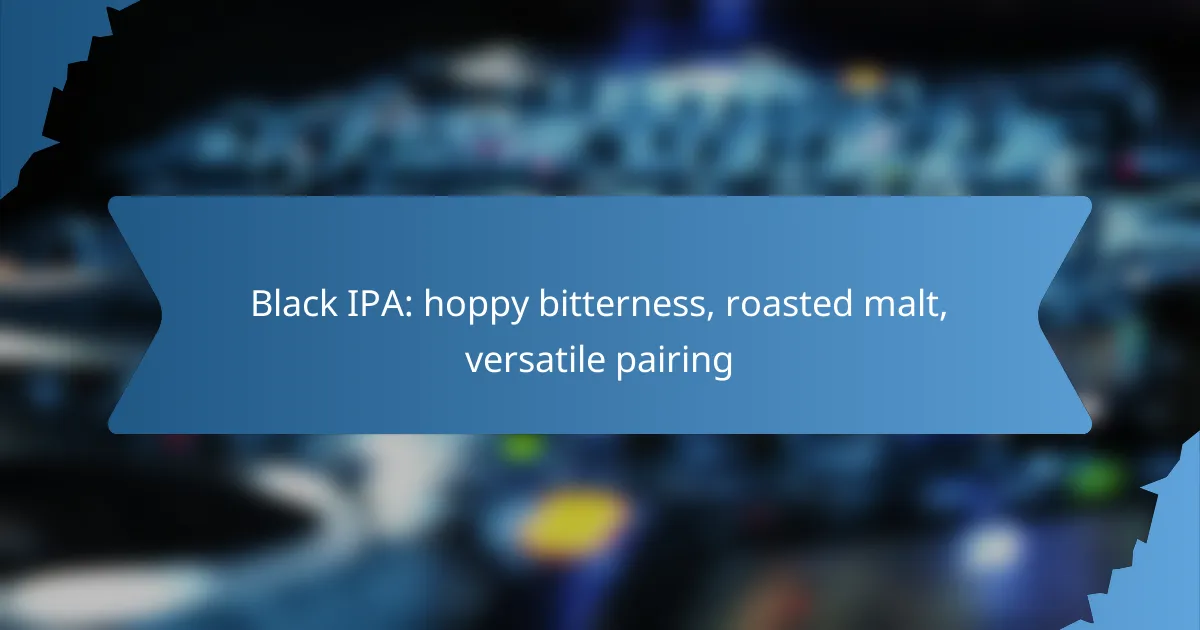Black IPA is a distinctive beer style that merges the hoppy bitterness of traditional IPAs with the rich, roasted malt flavors of darker brews. This unique combination creates a complex flavor profile that appeals to many palates, making it an excellent choice for versatile food pairings. Breweries like Stone & Wood, Balter, and Hawkers showcase this style, offering a balance that enhances both the beer and the meal experience.

What are the best Black IPAs available in Australia?
Some of the best Black IPAs in Australia include Stone & Wood, Balter, and Hawkers. These breweries offer unique takes on the style, balancing hoppy bitterness with roasted malt flavors, making them versatile for various food pairings.
Stone & Wood Black IPA
Stone & Wood’s Black IPA is known for its rich, roasted malt character complemented by a robust hop profile. This beer typically features notes of chocolate and coffee, balanced with citrus and pine aromas from the hops.
When enjoying this Black IPA, consider pairing it with grilled meats or hearty stews to enhance the flavors. Its complexity makes it a great choice for both casual and special occasions.
Balter Black IPA
Balter’s Black IPA stands out with its smooth mouthfeel and a blend of tropical and roasted flavors. The hops provide a vibrant bitterness that contrasts nicely with the dark malt sweetness, resulting in a well-rounded experience.
This beer pairs well with spicy dishes or rich cheeses, making it a versatile option for various meals. Its approachable flavor profile appeals to both IPA enthusiasts and those new to the style.
Hawkers Black IPA
Hawkers Black IPA is celebrated for its bold flavors and aromatic complexity. It combines dark malt characteristics with a punchy hop bitterness, creating a unique balance that captivates the palate.
For an ideal pairing, try it with barbecued foods or dark chocolate desserts. The interplay of flavors enhances both the beer and the dish, making for a memorable dining experience.

How to pair Black IPA with food?
Black IPA’s hoppy bitterness and roasted malt flavor make it a versatile choice for food pairings. It complements a variety of dishes, enhancing both the meal and the beer experience.
Grilled meats
Black IPA pairs exceptionally well with grilled meats due to its robust flavor profile. The hoppy bitterness cuts through the richness of fatty cuts like ribeye or pork belly, while the roasted malt complements the char from grilling.
Consider serving Black IPA with marinated chicken or lamb skewers, as the beer’s complex flavors enhance the spices and marinades. Aim for a balance where the beer’s bitterness matches the intensity of the meat.
Spicy dishes
The bitterness of Black IPA can effectively counterbalance the heat in spicy dishes. Whether it’s spicy tacos, curry, or buffalo wings, the beer’s hoppy notes provide a refreshing contrast to the heat.
When pairing, look for dishes with a moderate to high spice level. The roasted malt can also add depth, making it a great companion for dishes featuring bold flavors like chipotle or Szechuan peppercorns.
Chocolate desserts
Chocolate desserts and Black IPA create a delightful pairing, as the beer’s roasted malt enhances the chocolate’s richness. Dark chocolate brownies or chocolate stout cake can be particularly satisfying when enjoyed with this beer.
For the best experience, choose desserts that are not overly sweet, allowing the beer’s bitterness to balance the sweetness of the chocolate. A chocolate tart with a hint of sea salt can elevate the pairing even further.

What are the key characteristics of Black IPA?
Black IPA is a unique beer style that combines the hoppy bitterness of traditional IPAs with the roasted malt flavors typically found in darker beers. This results in a complex flavor profile that appeals to a wide range of palates, making it a versatile choice for various pairings.
Hoppy bitterness
The hallmark of Black IPA is its pronounced hoppy bitterness, which often comes from a variety of hops used during brewing. These hops can impart flavors ranging from citrusy to piney, creating a refreshing contrast to the darker malt characteristics. The bitterness level typically falls within the range of 40 to 70 International Bitterness Units (IBUs), making it comparable to many standard IPAs.
When selecting a Black IPA, look for those that balance hop bitterness with malt sweetness. This balance is crucial for an enjoyable drinking experience, as excessive bitterness can overshadow the rich malt flavors.
Roasted malt flavor
In addition to hoppy bitterness, Black IPAs feature a distinct roasted malt flavor that adds depth and complexity. The roasted malts contribute notes of chocolate, coffee, and caramel, which complement the hop profile. This combination creates a rich, layered taste that can be both bold and smooth.
When pairing food with Black IPA, consider dishes that can stand up to its robust flavors. Grilled meats, spicy foods, and rich cheeses work particularly well, as they enhance the beer’s roasted malt characteristics while balancing the hoppy bitterness.
Dark color
Black IPAs are characterized by their dark color, which typically ranges from deep brown to black. This color is achieved through the use of specialty malts that not only contribute to the visual appeal but also enhance the flavor profile. The darkness of the beer can be misleading, as it often has a lighter body compared to its appearance.
When serving Black IPA, consider using clear glassware to showcase its rich color. This visual aspect can enhance the overall drinking experience, inviting drinkers to appreciate both the look and the taste of this distinctive beer style.

What is the brewing process for Black IPA?
The brewing process for Black IPA involves a careful balance of dark malts and hops to create a beer that is both hoppy and roasted. Typically, brewers start with a base of pale malt, then incorporate specialty dark malts to achieve the desired color and flavor profile while using late hop additions to enhance the aromatic qualities.
Use of dark malts
Dark malts are essential in brewing Black IPA as they contribute to the beer’s rich color and complex flavors. Commonly used malts include roasted barley, chocolate malt, and black malt, which impart notes of coffee, chocolate, and caramel. The key is to use these malts in moderation to avoid overwhelming the hop character.
When selecting dark malts, brewers often aim for a color range of 40 to 80 Lovibond. This ensures a deep hue without excessive bitterness, allowing the hoppy bitterness to shine through. A good practice is to limit dark malt usage to around 10-20% of the total grain bill.
Late hop additions
Late hop additions are crucial for achieving the signature hoppy bitterness in Black IPA. By adding hops during the last stages of the boil, brewers maximize the aroma and flavor while minimizing bitterness. Common hop varieties include Cascade, Centennial, and Simcoe, which provide citrus and pine notes that complement the roasted flavors.
Brewers typically add hops within the last 15 to 5 minutes of the boil. This technique can also include dry hopping during fermentation, which enhances the hop aroma further. A common approach is to use a combination of both methods to achieve a balanced profile.
Fermentation techniques
Fermentation techniques play a significant role in the final character of Black IPA. Most brewers use American ale yeast, which ferments cleanly and allows the hop and malt flavors to shine. The fermentation temperature is typically maintained between 18-22°C (64-72°F) to promote a robust flavor profile without excessive esters.
To enhance the beer’s complexity, some brewers experiment with different yeast strains or even blend yeasts. Additionally, controlling oxygen exposure during fermentation is crucial to prevent off-flavors. A common pitfall is to rush the fermentation process; allowing adequate time for conditioning can significantly improve the beer’s overall quality.

How does Black IPA compare to other IPA styles?
Black IPA combines the hoppy bitterness typical of IPAs with the roasted malt flavors found in darker beers. This unique blend sets it apart from other IPA styles, offering a complex flavor profile that appeals to a wide range of beer enthusiasts.
Difference from American IPA
American IPA is characterized by its strong hop presence and lighter color, typically ranging from golden to amber. In contrast, Black IPA features a darker hue due to the use of roasted malts, which contribute to its unique flavor profile while still maintaining a significant hop bitterness.
The hop varieties in American IPAs often showcase citrus and pine notes, while Black IPAs can incorporate similar hops but are balanced with chocolate and coffee undertones from the darker malts. This results in a more complex taste experience that appeals to those who enjoy both hoppy and roasted flavors.
Difference from Brown IPA
Brown IPA blends the malt-forward characteristics of brown ales with the hop bitterness of IPAs, resulting in a beer that is generally less hoppy than Black IPA. While both styles feature darker malts, Black IPA emphasizes hop bitterness more prominently, leading to a bolder flavor profile.
In terms of sweetness, Brown IPAs often have a richer, caramel-like sweetness due to the malt, whereas Black IPAs balance this sweetness with a more pronounced bitterness. This makes Black IPAs a versatile option for those looking to explore the interplay between hops and roasted malt flavors.
